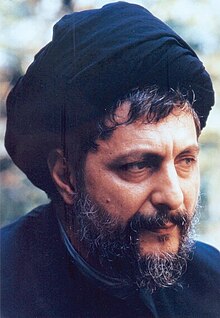Musa al-Sadr | |
|---|---|
موسى صدر الدین الصدر | |
 | |
| 1st Leader of the Amal Movement | |
| In office 6 July 1974 – 31 August 1978 | |
| Preceded by | Office established |
| Succeeded by | Hussein el-Husseini |
| 1st President of the Supreme Islamic Shia Council | |
| In office 23 May 1969 – 31 August 1978 | |
| Preceded by | Office established |
| Succeeded by | Mohd. Mehdi Shamseddine |
| Personal details | |
| Born | 4 June 1928[1] Qom, Imperial State of Persia (present-day Iran[2]) |
| Died | Unknown |
| Resting place | Unknown |
| Political party | |
| Other political affiliations | Supreme Islamic Shia Council |
| Spouse | Parvin Khalili |
| Parent |
|
| Relatives | Ismail Sadr (grandfather) Haydar Sadr (uncle) Muhammad Sadr (cousin) Sadeq Tabatabaei (nephew) Zohreh Sadeghi (niece) |
| Alma mater | University of Tehran Qom Seminary |
| Profession | |
| Nicknames |
|
| Went missing on 31 August 1978 (aged 50) in the Libyan Arab Jamahiriya[3] and has been Missing for 46 years, 2 months and 26 days | |
| Part of a series on |
| Amal Movement |
|---|
Musa Sadr al-Din al-Sadr (Arabic: موسى صدر الدین الصدر) (Persian: موسى صدر الدين صدر); 4 June 1928 – disappeared 31 August 1978) was a Lebanese-Iranian Shia Muslim cleric, politician and revolutionary In Lebanon, he founded and revived many Lebanese Shia organizations, including schools, charities, and the Amal Movement.[4]
Born in the Chaharmardan neighborhood in Qom, Iran, he underwent both seminary and secular studies in Iran. He belongs to the Al-Sadr family from Jabal Amel in Lebanon, a branch of the Musawi family which traces its roots to Musa Ibn Jaafar, the seventh Shia Imam, and ultimately to the Islamic prophet Muhammad through his daughter Fatima. Therefore, Musa al-Sadr is often styled with the honorific title Sayyid. He left Qom for Najaf to study theology and returned to Iran after the 1958 Iraqi coup d'état.
Some years later, al-Sadr went to Tyre, Lebanon as the emissary of Ayatollahs Borujerdi and Hakim. From Tyre, he published the periodical, Maktabi Islam.[5] Fouad Ajami called him a "towering figure in modern Shi'i political thought and praxis".[6] He gave the Shia population of Lebanon "a sense of community".[7]
On 25 August 1978, Sadr and two companions, Sheikh Mohamad Yaacoub and Abaass Bader el Dine, departed for Libya to meet with government officials at the invitation of Muammar Gaddafi. The three were last seen on 31 August. They were never heard from again. Many theories exist around the circumstances of al-Sadr's disappearance, none of which have been proven. His whereabouts remain unknown to this day.
- ^ سيرة سماحة الإمام القائد السيد الصدر Archived 21 February 2006 at the Wayback Machine Arabic
- ^ Ende, W. (2012). "Mūsā al- Ṣadr". Encyclopedia of Islam. Brill.
- ^ Cite error: The named reference
yal3sepwas invoked but never defined (see the help page). - ^ Chehabi, Hussein; Abisaab, Rula Jurdi (2006). Distant Relations: Iran and Lebanon in the Last 500 Years. I.B.Tauris. ISBN 978-1860645617.
- ^ Najem, Tom; Amore, Roy C.; Abu Khalil, As'ad (2021). Historical Dictionary of Lebanon. Historical Dictionaries of Asia, Oceania, and the Middle East (2nd ed.). Lanham Boulder New York London: Rowman & Littlefield. p. 265. ISBN 978-1-5381-2043-9.
- ^ Nasr, Seyyed H. (1989). Expectation of the Millennium: Shiʻism in History. Albany, NY: State University of New York Press, Albany. p. 425. ISBN 9780887068430., chapter 26
- ^ Cite error: The named reference
abawwas invoked but never defined (see the help page).